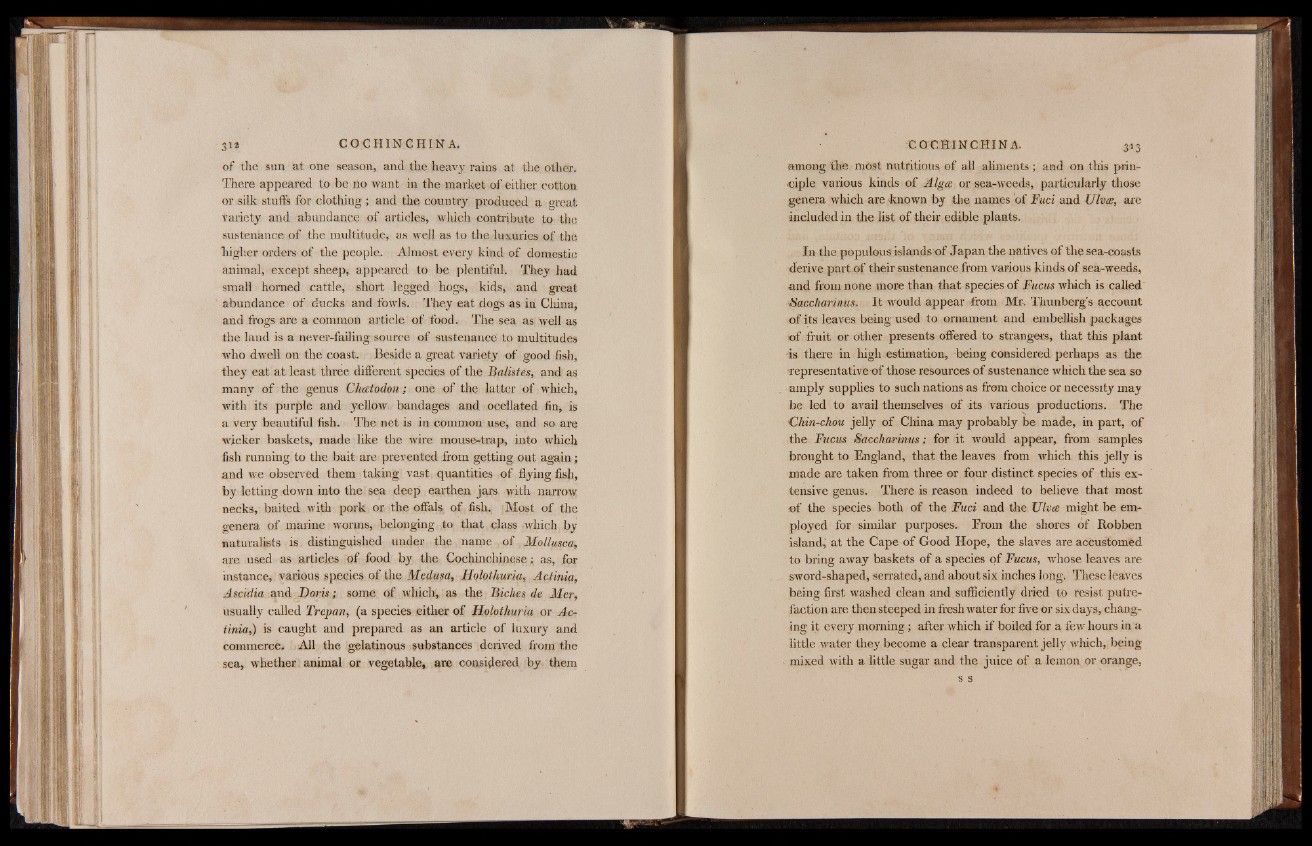
of the sun at one season, and the heavy rains at the other.
There appeared to be no want in the market of either cotton
or silk stuffs for clothing ; and the country produced a great
variety and abundance of articles, which contribute to the
sustenance of the multitude, as well as to the luxuries of the
higher orders of the people. Almost every kind of domestic
animal, except sheep, appeared to be plentiful. They had
small homed cattle, short legged hogs, kids, and great,
abundance of ducks and fowls. They eat dogs as ia China,
and frogs are a common article of food. The sea as well as
the laud is a never-failing source of sustenance to multitudes
who dwell on the coast. Beside a great variety of good fish,
they eat at least three different species of the Batistes, and as
many of the genus Chcetodon; one of the latter of which,
with its purple and yellow bandages and ocellated fin, is
a very beautiful fish. The net is in common use, and so are
wicker baskets, made like the wire mouse-trap, into which
fish running to the bait are prevented from getting out again;
and we observed them taking vast quantities of flying fish,
by letting down into the sea deep earthen jars with narrow
necks, baited with pork or the offals, of fish. Most of the
genera of marine worms, belonging to that class which by
naturalists is distinguished under the name of Mollusca,
are used as articles of food by the Cochinchinese; as, for
instance, various species of the Medusa, Holothuria, Actinia,
Ascidia and Doris; some of which, as the Biches de Mer,
usually called Trepan, (a species either of Holothuria or Actinia,)
is caught and prepared as an article of luxury and
commerce. All the gelatinous substances derived from the
sea, whether animal or vegetable, are considered by them
among the most nutritious of all aliments; and on this principle
various kinds of Alga or sea-weeds, particularly those
genera which are known by the names of Fuci and TJlvee, are
included in the list of their edible plants.
In the populous islandsof Japan the natives of the sea-coasts
derive part of their sustenance from various kinds of sea-weeds,
and from none more than that species of Fucus which is called
Sacchariniis. It would appear from Mr. Thunberg’s account
of its leaves being used to ornament and embellish packages
of fruit or other presents offered to strangers, that this plant
is there in high estimation, being considered perhaps as the
^representative of those resources of sustenance which the sea so
amply supplies to such nations as from choice or necessity may
be led to avail themselves of -its various productions. The
Chin-chou jelly of China may probably be made, in part, of
the Fucus Saccharinus; for it would appear, from samples
brought to England, that the leaves from which this jelly is
made are taken from three or four distinct species of this extensive
genus. There is reason indeed to believe that most
o f the species both of the Fuci and the Ulvce might be employed
for similar purposes. From the shores of Robben
island,; at the Cape of Good Hope, the slaves are accustomed
to bring away baskets of a species of Fucus, whose leaves are
sword-shaped, serrated, and about six inches long. These leaves
being first washed clean and sufficiently dried to resist putrefaction
are then steeped in fresh water for five or six days, changing
it every morning; after which if boiled for a few hours in a
little water they become a clear transparent jelly which, being
mixed with a little sugar and the juice of a lemon or orange,
s s